Although Inter Milan have been crowned Serie A champions already, the Derby d’Italia was still a meaningful clash as Juventus were in their biggest spot of bother since finishing seventh in the 2010-11 season. Andrea Pirlo’s team are in serious danger of missing out on a top four spot, and therefore a place in next season’s Champions League, for the first time in ten years, and came into this match desperately needing a win to keep in touch with Napoli and AC Milan in the table.
The match itself was a bonkers one, with both teams’ tactics being overshadowed by the referee’s performance. While Juventus dominated the first half, as seen by the respective shot tallies at that time (10 for Juve vs just one for Inter), this dynamic changed completely in the second half after Rodrigo Bentancur was sent off. Our tactical analysis will show the most interesting tactical elements of this match, as well as how both coaches reacted to each other’s changes.
Lineups
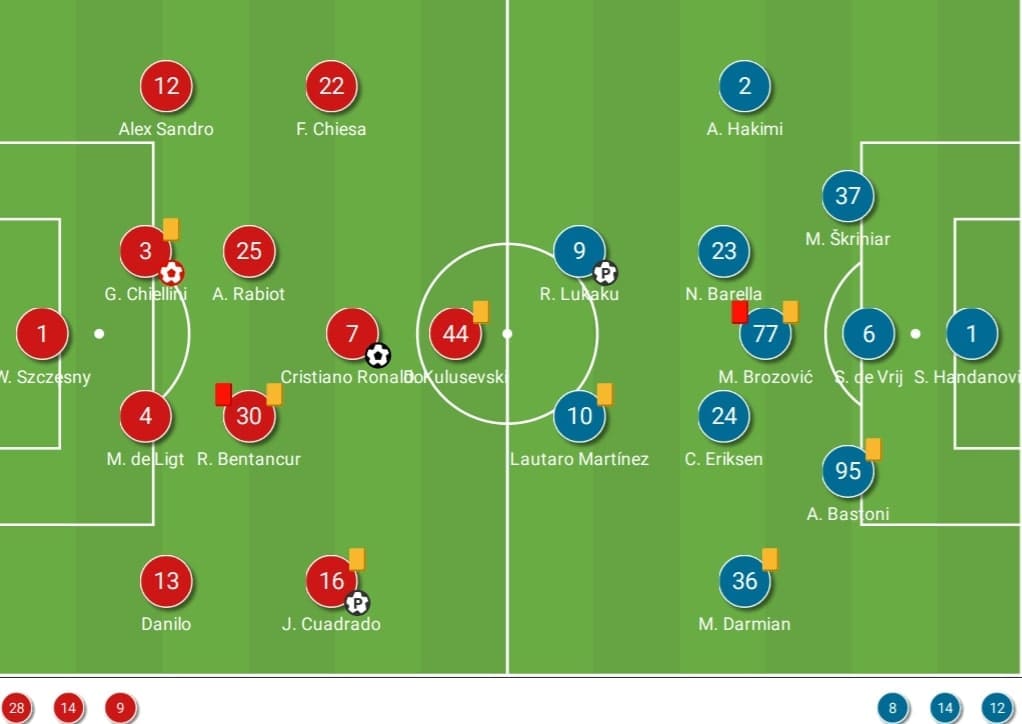
There were no real surprises in the Juventus lineup – Pirlo sent out an extremely strong side, with Dejan Kulusevski supporting Cristiano Ronaldo in attack, the Brazilian pair of Alex Sandro and Danilo at full-back, and with the 32-year-old Juan Cuadrado pushed up on the flank from where he would have a significant impact on this match.
Inter Milan also put out a strong lineup, after Antonio Conte had rested a few players following their Serie A triumph. The Romelu Lukaku-Lautaro Martínez partnership returned, while Christian Eriksen, Marcelo Brozović, and Nicolò Barella started in midfield in Conte’s classic 3-5-2 formation.
Battles in the wide zones
Juventus pressed extremely hard and high in the opening stages – even with a 36-year-old Ronaldo leading the line, who was never someone to run hard for the team defensively even during his prime, Pirlo put a pressing system in place which made it difficult for Inter to play out from the back.
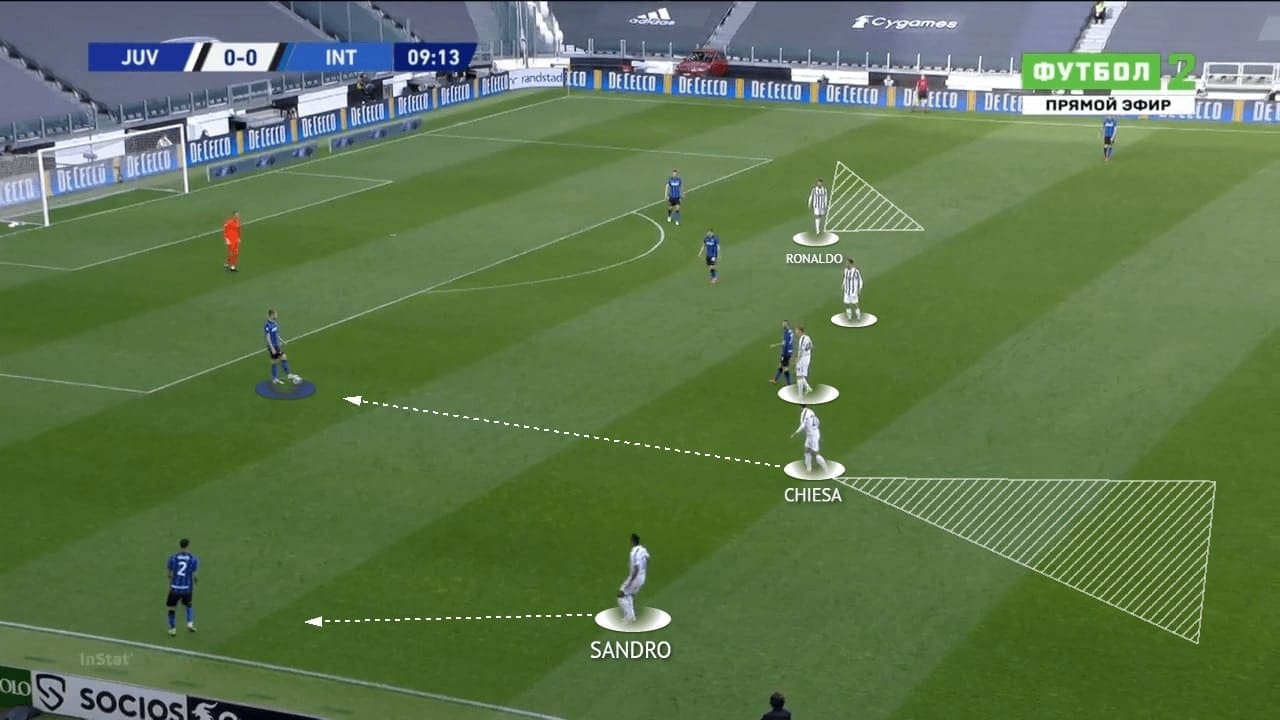
The strategy was to press on one side while committing the full-backs to close down the wide zones. By asking Ronaldo to stay on the other side, covering the ball-far wing-back and centre-back, Juventus could prevent a switch of play as indicated in the above image.
Pirlo instructed Kulusevski to man-mark Brozović tightly, inviting Inter to pass through the wing-backs instead of going to the centre. Another strategy to block the central zone was to position the wingers in the half-spaces initially to shut vertical passing channels. Federico Chiesa’s positioning is a good example in this image. When Milan Škriniar passed to Achraf Hakimi, Alex Sandro was on hand to press the Moroccan, with Chiesa providing support as well.
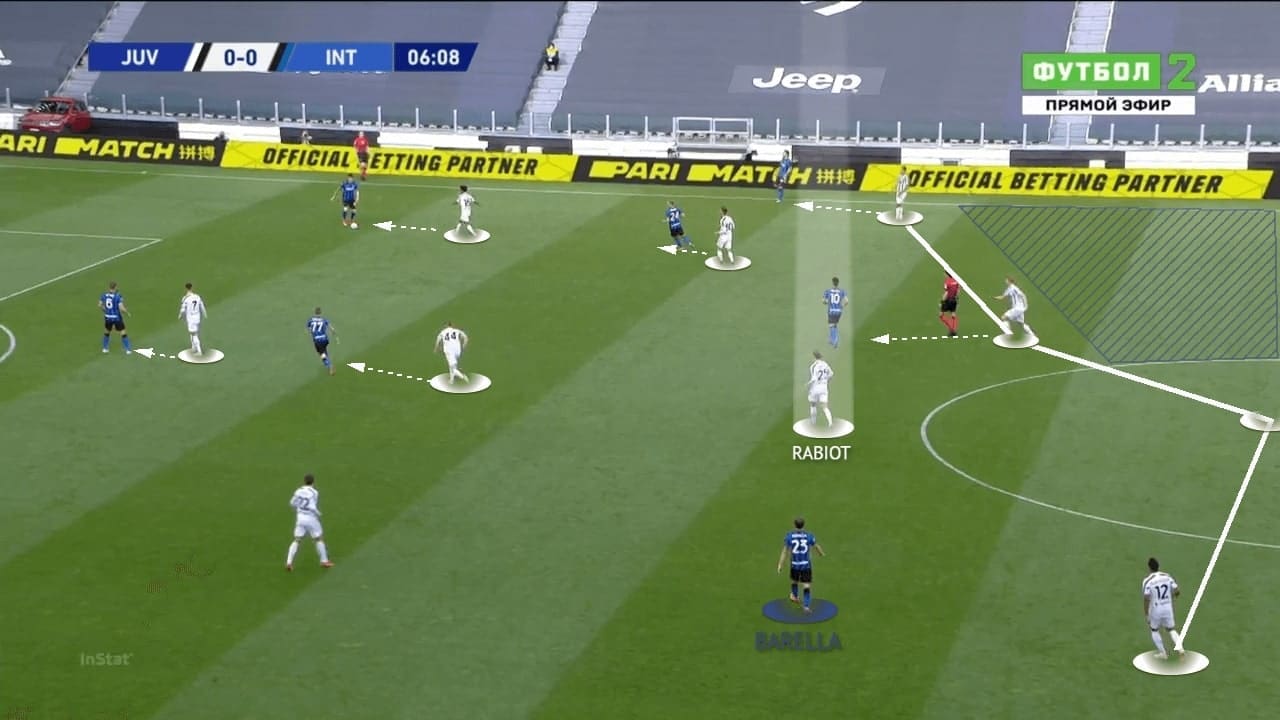
This image gives us a clearer picture of how Juventus pressed at one flank. Rabiot’s positioning balances the structure, as Juventus commit more players than Inter to the flank. Although it was a 3v3 in midfield, the Juve midfielders had to stay deeper to defend central zones instead of following their opponents in a man-oriented manner. If Rabiot was pulled away by Barella, Matthijs de Ligt would be in trouble, having to defend against Martínez in huge spaces.
Juventus could go man-to-man on the ball-side with the winger pressing the wide centre-backs, the full-backs on the wing-backs, the ball-near midfielder on a midfielder, and Kulusevski on Brozović. With this marking scheme, they also made the ball-playing zone small when the Inter players were moving towards the ball. Again, Ronaldo’s task was to prevent a switch by staying around the other centre-backs.
Since the hosts were very committed to trap the opposition at one side with defenders stepping up in advance, they conceded spaces behind the high line and these were the areas (blue zone) that Inter looked to exploit in their game plan.
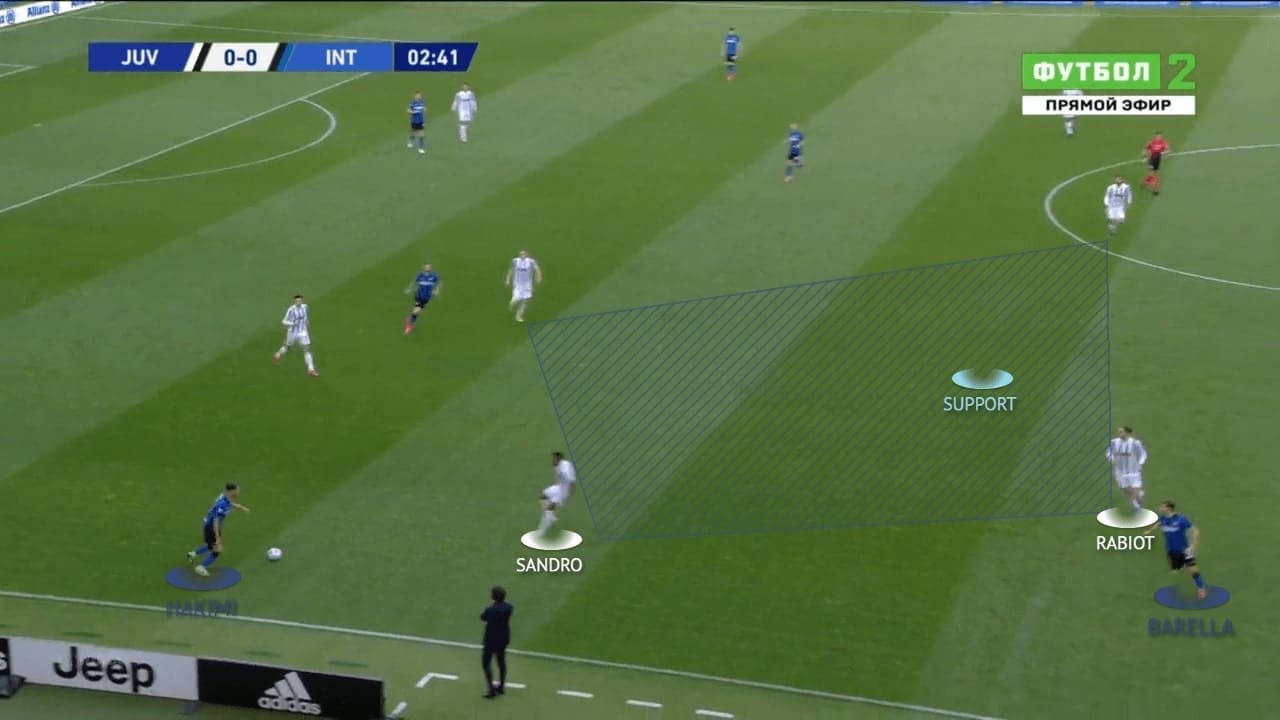
In the first half, Inter struggled to break the press as the attack was trapped at the wide zones too many times. They could not find the right space or release the free player, but only keep playing long balls to try and attack spaces in behind the Juventus defensive line.
In this image, Achraf Hakimi receives and turns with Sandro trying to press but arriving late. This was a common issue for Juventus as the full-backs had a lot of space to cover to press Inter’s wing-backs, who stayed deep, but the away side were unable to take advantage of this.
With Barella’s diagonal movements to the outside, Inter always brought the ball-side midfielder away from the half-spaces and this dragged Rabiot out as well, as we can see. However, Inter did not exploit those spaces as no one dropped into the zone as highlighted. A return pass to the centre-backs was not possible as Chiesa was ready to press the wide centre-backs.
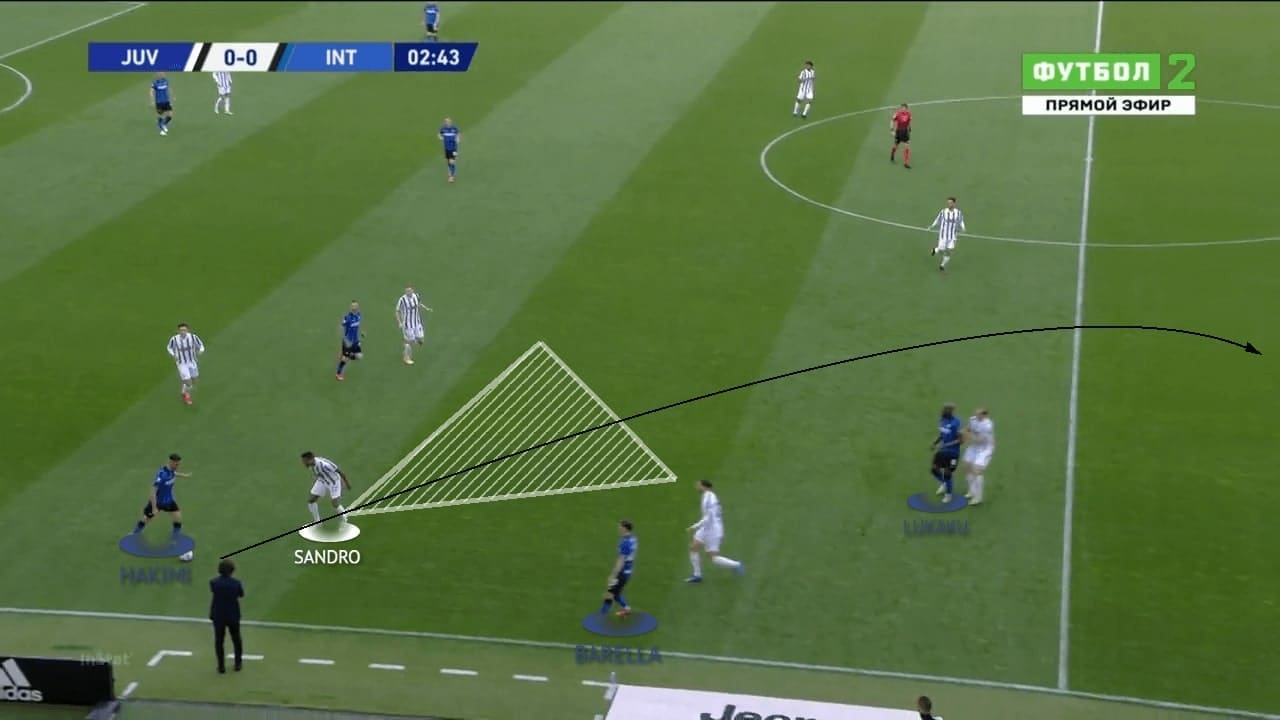
Sandro does not block the pass down the line from Hakimi, but stays a little central to cover the half-space, which gives the wing-back room to make a direct pass.
Very intriguingly, the Brazilian international did not block the stronger foot of Hakimi, but trying harder to cover the half-spaces, he had given Hakimi some spaces to play as Juventus were ready to defend the direct passes.
Therefore, Hakimi could only play a long ball to hit spaces behind the defence as there was no option at half-spaces. Martínez would be chasing after the direct passes but struggled to cope with the defending of de Ligt in the first half.
Flexibility of Eriksen
However, when Juventus became more passive in the second half, Inter no longer struggles to develop the attack because of taking the initiative. The hosts went deeper to defend in a 4-4-1-1 midblock as the game developed, but this would let Inter play very easily and they kept conceding chances after that.
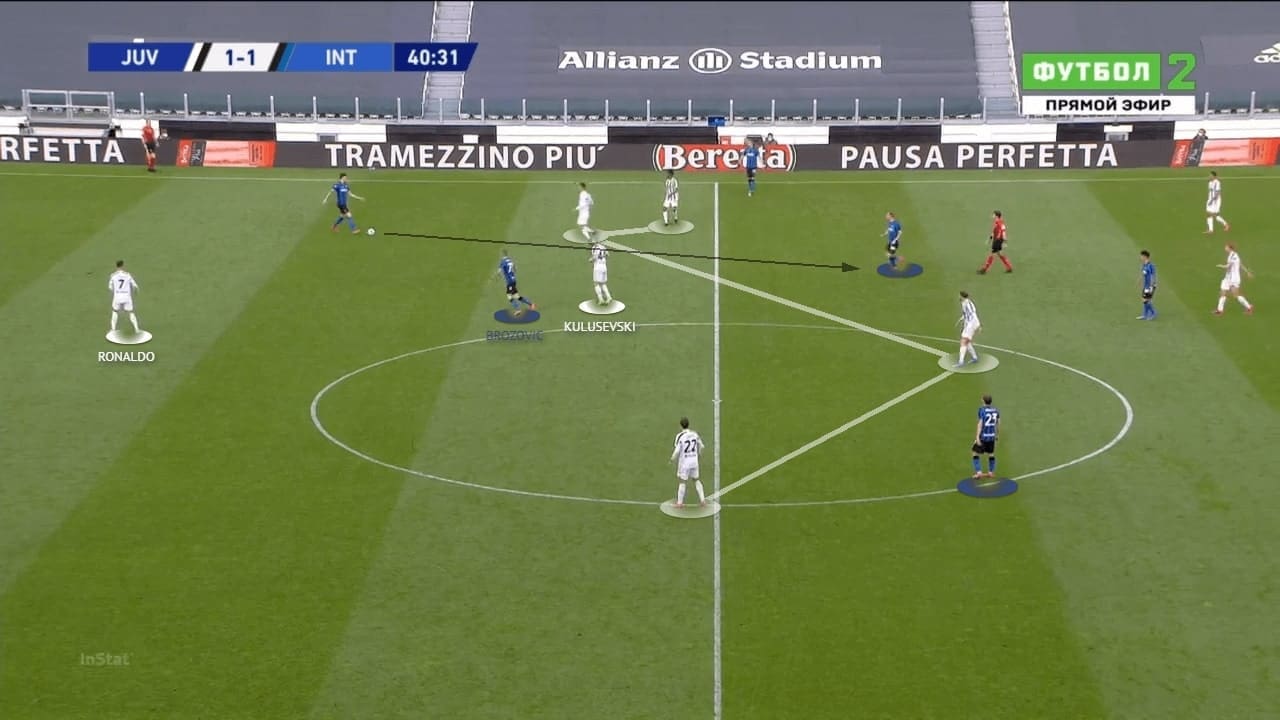
The image shows the 4-4-1-1 midblock of Juventus. Ronaldo and Kulusevski’s positions were different from the team sheet as Pirlo wanted the Swedish international to defend deeper, having greater control over Brozović. So, Ronaldo could stay higher and be a part of the rest offence, possibly triggering the counter-attacks.
Although it was a situation in the first half, some issues of Juventus were already suggested in the example. Their defence lacked contacts and intensity when pressing, which allowed Inter too many spaces to play. When the ball-near winger was defending the wing-back and being pulled deeper, the midfielders were forced to press the wide centre-backs. However, the distance to travel from midfielder (original targets to mark) to defender was too large, hence, they were late to arrive.
Bentancur was pressing Alessandro Bastoni in this image but could not make the contacts, also, struggled to cover Eriksen in his shadow. Then, Juventus’ spaces behind the midfield were exploited by one simple vertical pass and they needed to defend closer to their goal.
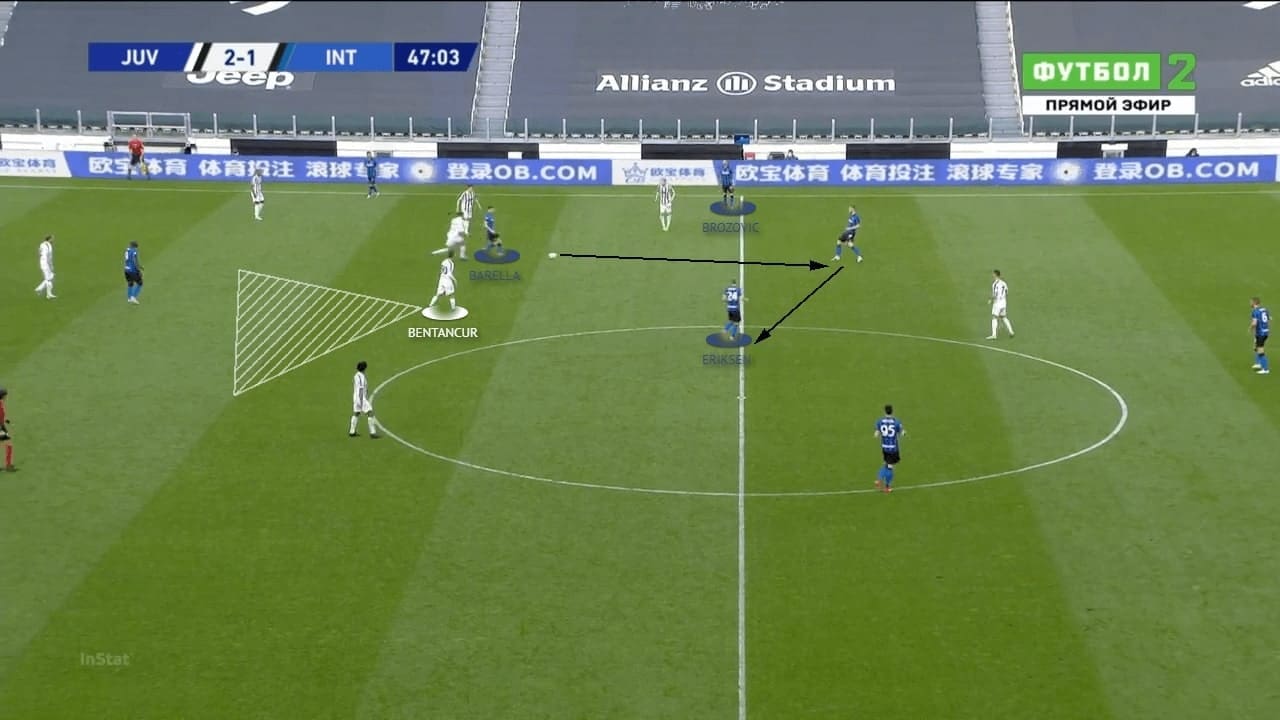
In the second half, Inter realized the issues of Juventus’ defence and exploited them cleverly by manipulations. They offered greater freedom to Eriksen to drop deep, moving Brozović away from the pivotal deep-lying role. When the Croatian international moved, he would take Kulusevski with him, opening spaces at the centre for the build-up.
The image shows how easily Inter beat the midblock of Juventus. Barella played the ball back to the centre-back, who would not receive the pressure from Ronaldo. Then, quickly they found Eriksen at the central circle who could pass the ball into the opposite side or even into the final third. Those spaces were created because of the following reasons: Brozović was out wide and dragged the marker, so they had rooms at the midfield. Also, Juventus’ midfielder – Bentancur was reluctant to leave his defending zone as he prioritized covering Rabiot, so he let Eriksen dropped and receive easily.
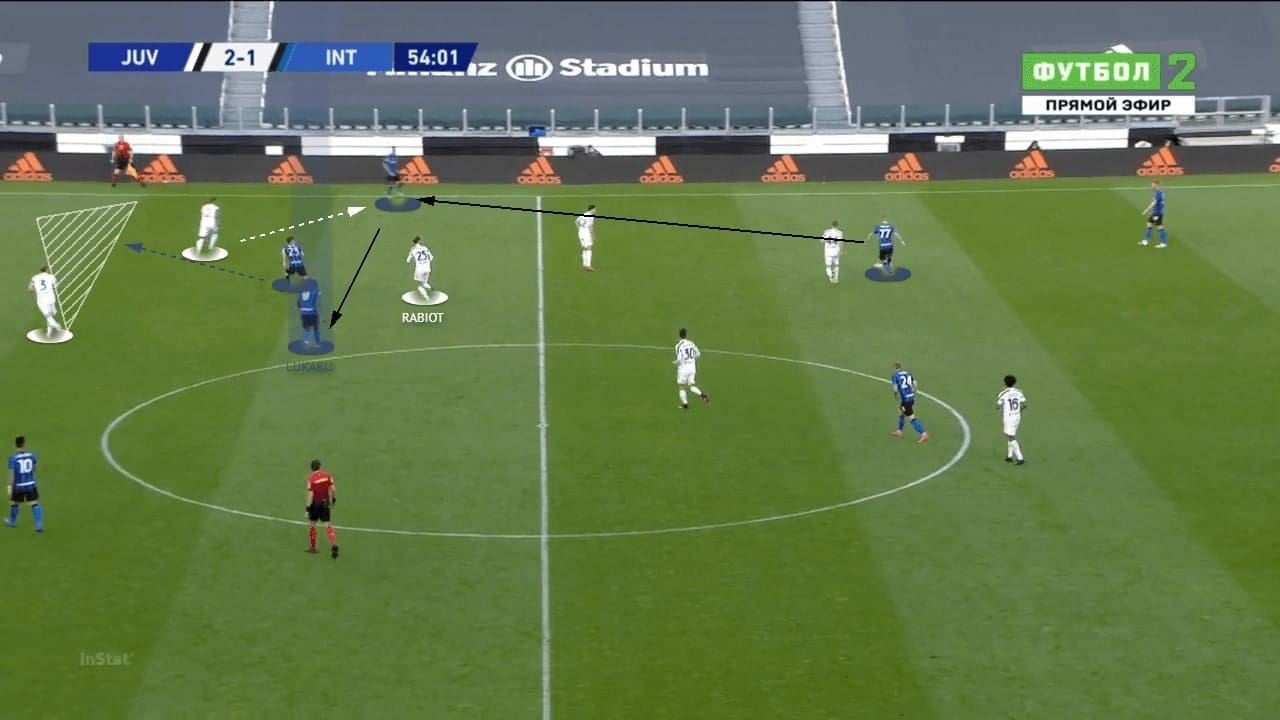
When Juventus were defending deeper, they let Inter organizing the attack too easily and this was how Bentancur was sent off. The attack began from Brozović, a target that should be tightly marked by Kulusevski but he failed to put enough pressure. A wide pass was easily spread to Hakimi, then, the hosts did their usual shift by using the left-back to press.
But when Barella made the forward movement, Rabiot was totally off from him, he should have tracked that run instead of leaving the job to Giorgio Chiellini. Therefore, the Italian defender could not stay with Lukaku, Inter easily entered spaces behind the midfield. All of a sudden, Bentancur lost his brain and tackled without necessity, Juventus were down to 10-man.
Juventus’ offensive issues
Pirlo’s troops scored three in this game but that does not mean the attack was perfect. On the contrary, Juventus also need to improve the attack as they could not enter the final third under good conditions.
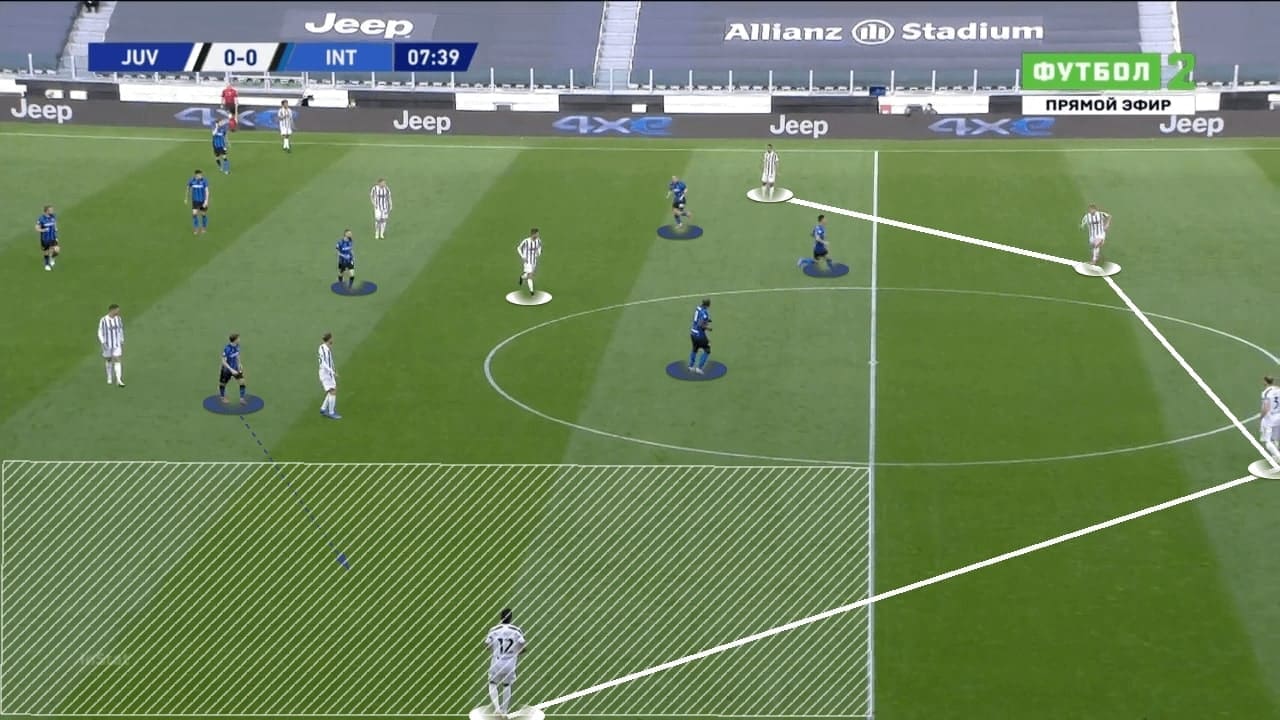
In the first phase, Juventus played in a wide 4-1 shape with Bentancur staying deeper. Since Inter defended with a 5-3-2 midblock, which could be differentiated as the pressing five and the back five, Pirlo wanted to stretch the former part to open spaces at the centre. The setup of Conte’s team was to use the wide midfielders to press the full-backs, while keeping the strikers to engage the centre-backs. By maintaining a wide shape, theoretically, the hosts could find spaces at the inside when the wide midfielders came out to press.
However, as we have shown in this image, the Inter block was compact at the centre. Wide midfielders would only step up after the wide distribution, so they covered Juventus’ central players when pressing the outside. This suggested Juventus were not finding spaces inside, but more often at flanks as highlighted in white.
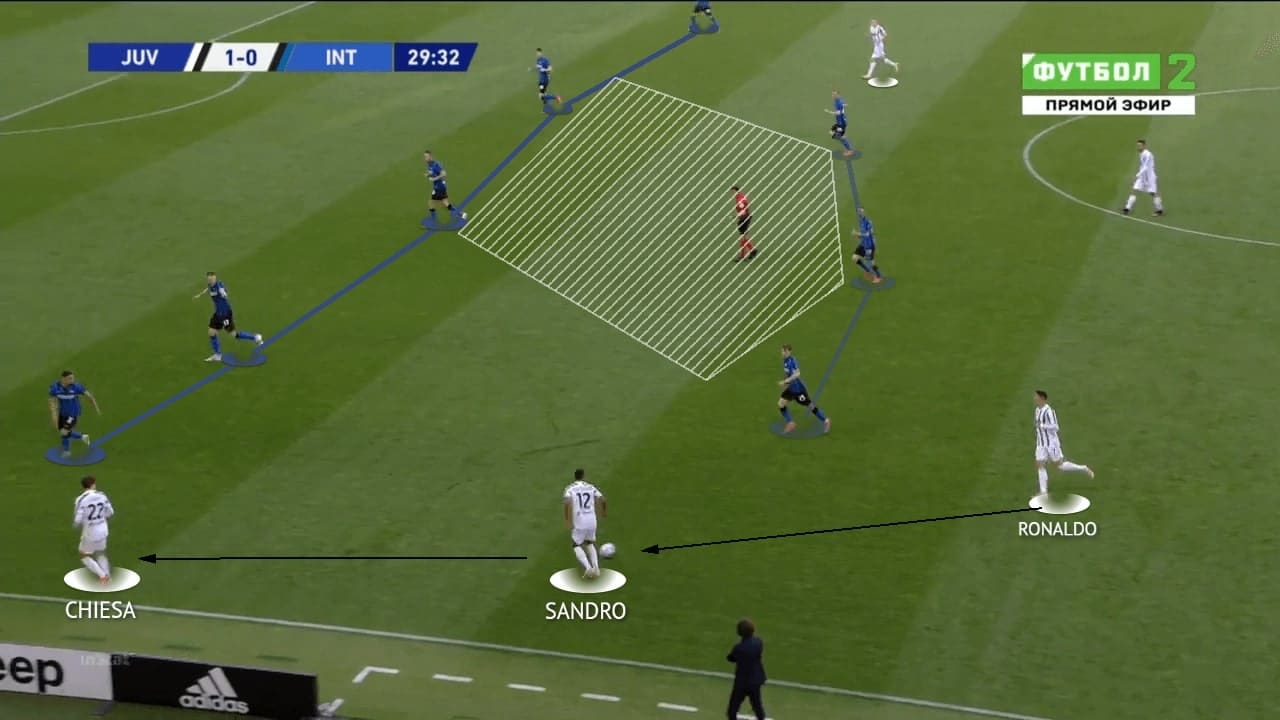
That’s why many Juventus attacks developed at flanks, and they were not effective because of the following issues. Firstly, the attack carried too much verticality, winger easily overcrowded the same corridor with the full-back when Juventus played the ball wide. For example, Chiesa and Sandro duplicated in the wide zone in the image. This resulted in suboptimal body receiving shape and the Old Ladies could only attack the flank with individual qualities instead of short and quick combinations.
Secondly, the habit of Ronaldo became a drawback in this game. The Portuguese international always dropped deep out to receive at feet instead of running into spaces, Juventus lost control at the central areas when attacking. Ideally, as suggested on the team sheet, Kulusevski should have filled the vacancy when Ronaldo left, but the former Parma player did not offer enough runs behind the defence either.
As a result, as shown in the image, the white zone was completely free while Inter were defending with a back five, the centre-backs were without any worry.
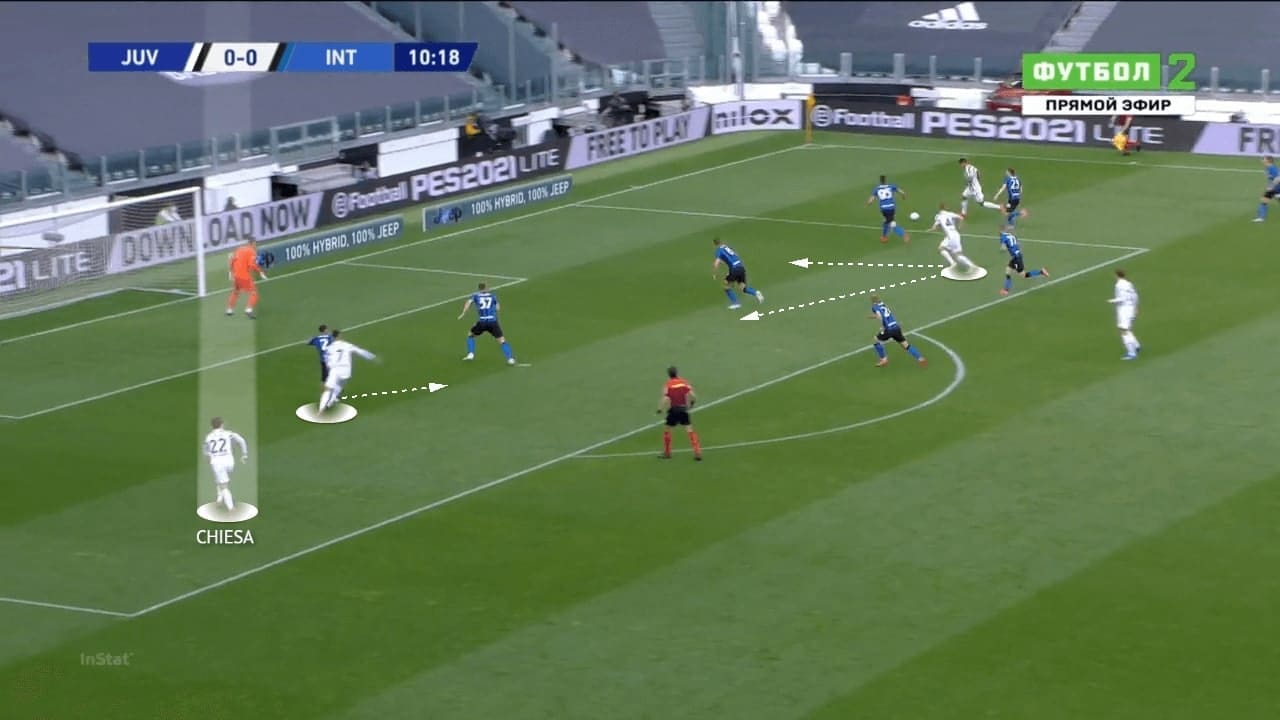
One thing Juventus had been doing well this season was to commit numbers into the penalty box. This was one of the core ideas of Pirlo’s philosophy and they always create favourable situations with that. The far-side winger was expected to come inside to the box early and attack the blindside of the last defender, this dynamic movement was the most difficult to track and Juventus almost got an early lead with that.
Here, Ronaldo made a near-side movement while occupying Hakimi with him. Consequently, Chiesa was left totally free at the far-side and the cross reached him. This chance was a huge one and Juventus should have buried it.
Final remarks
As we have shown in this analysis, Juventus were better than Inter in the first half when they pressed high, but quickly dipped after defending in a midblock. Also, offensively they had some struggles to reach the final third with good conditions, they scored controversial goals and luckily grabbed all points. Inter and Conte’s quick adjustments during the break showed why they are the champion, of course, losing the game did not make damages.
Deserved three-point or not, it was an objective perception, and everyone could have a different answer. Tactically, Pirlo still stuck tightly to his ideas and philosophies despite not having a good season, but the defensive issues must be solved as soon as possible. This game was a good hint on how Juventus could bottle the lead when not applying the pressure enough, similar situations should be avoided in the remaining games.





Comments